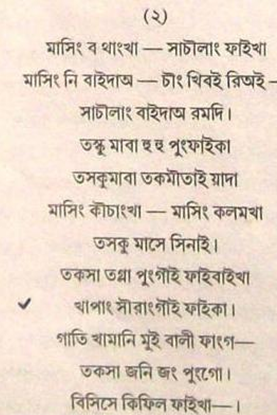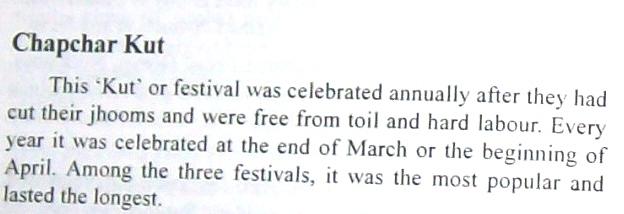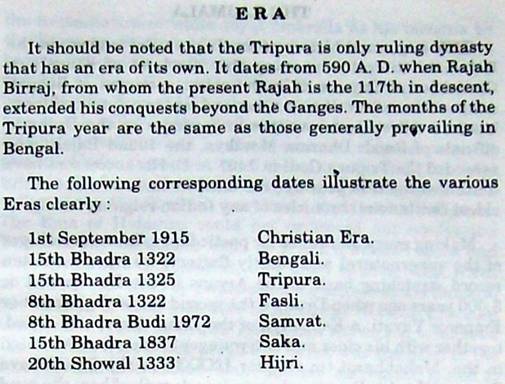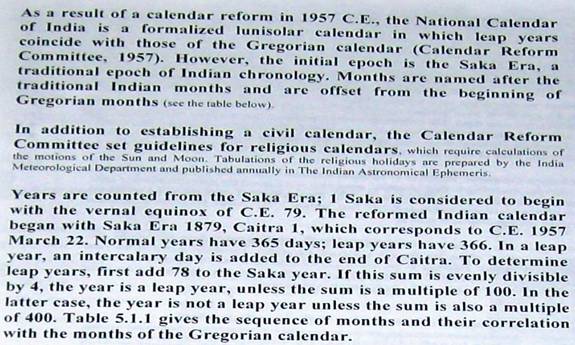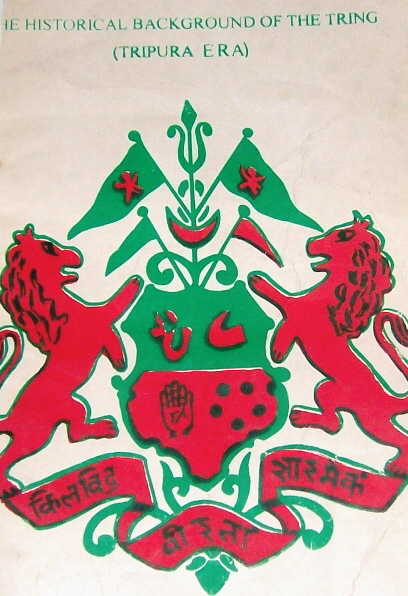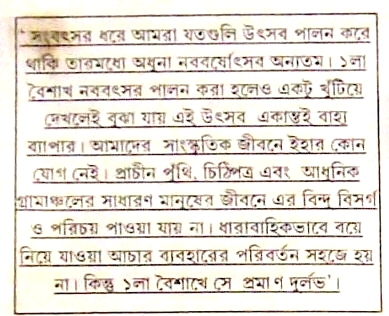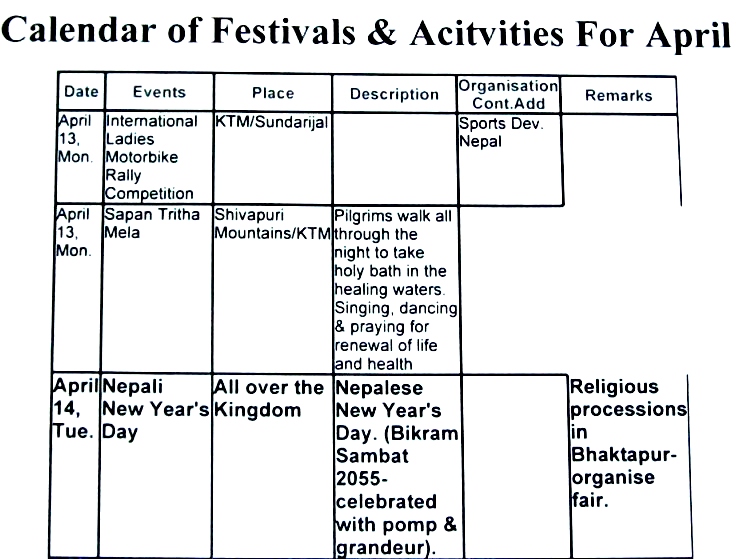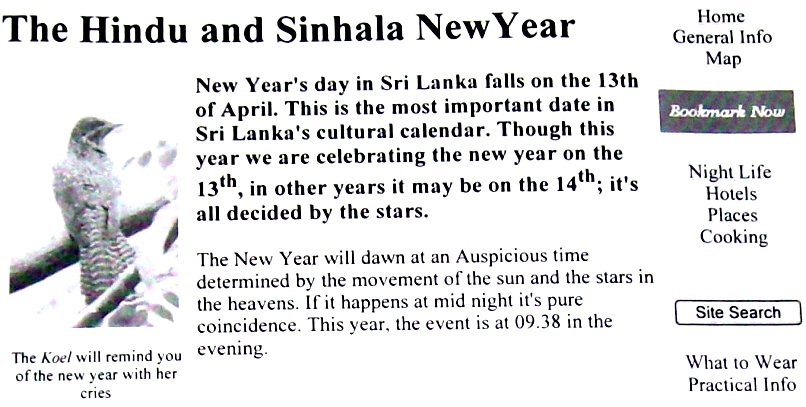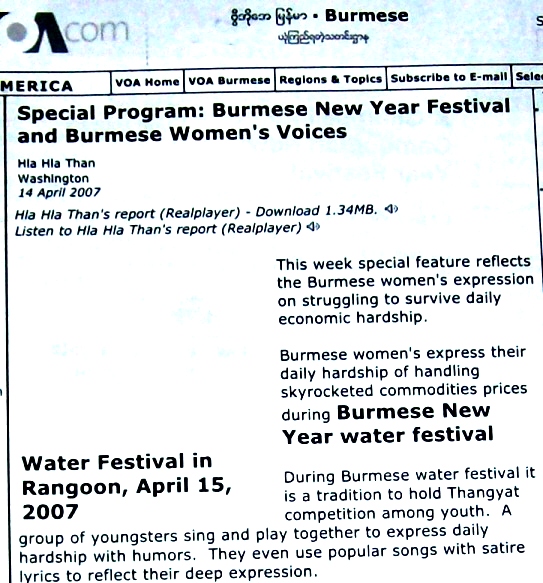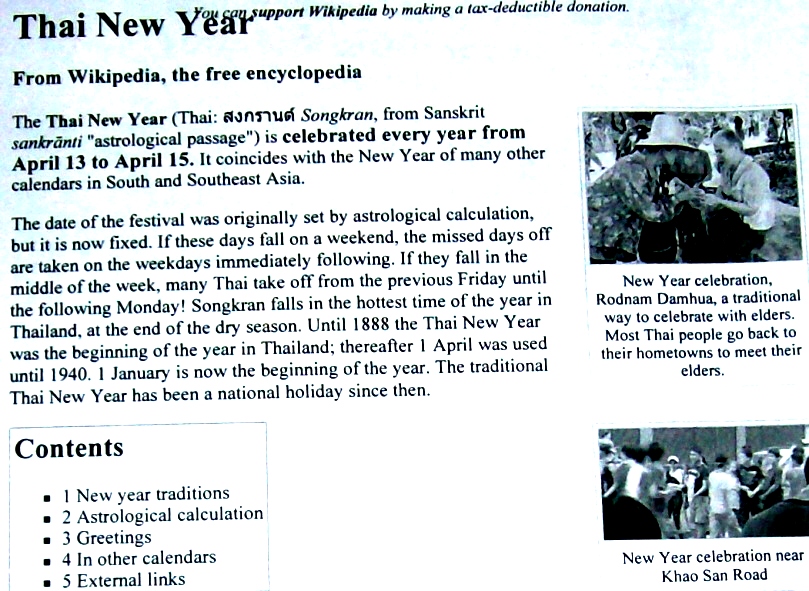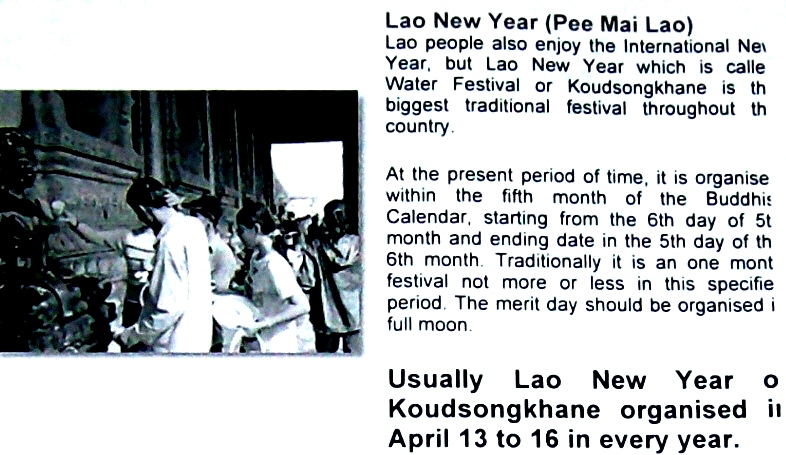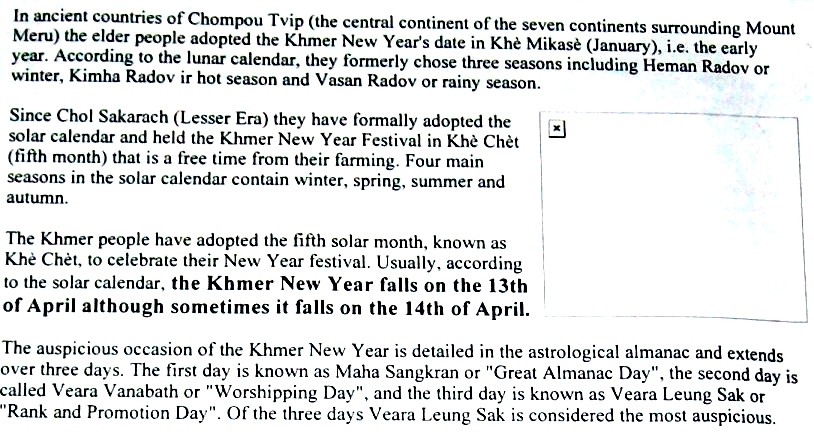|
Tripura is one of the few states whose royal dynasty had its own era. The
Tripura Era was the only era used during the Manikya dynasty rule of five
thousand years history. In all the official communications, royal communiqué,
religious and cultural sphere the Tripura Era was only used during the Raj
period. Cultural Evidence of Tripura New Year in 14th April or 1st Vaisakh: There are endless cultural evidences which proves that Tripura Era New Year was in first of Vaisakh or 14th April. These are many folk songs which directly proves which day is the New Year of Tripura Era. Though the western culture influenced over enthused youths took the references of such Tripuri folk songs, but its actual meaning were all misinterpreted. Here are some of the songs taken references from the ‘Prachin Tripuri Lok Sangeet Sankolon.' By Narendra Debbarma.
This book was written long back in the year 1974 AD. It is the collection of folksongs from sang by various radio folk artists from all over the state of Tripura during that period.
The above Tripuri folksong lyric is translated in English as "When Fifteenth of Magh month has passed, Falgun month starts peeping, in the fifteenth of Falguna, Chaitra month starts to peep, and Majhilata (Madhavi) flower starts to blossoms. Wild Khummake flower starts to blossoms and Lord Goria comes to this world. At the end of Chaitar month, New year Vaisakha will come and sowing of paddy in the Huk or Jhum will have to begin."
The above lyric is translated as, "The winter is over, spring has arrived, leave the winter apparels, and take the spring apparels. Toskuma bird has tweeting huhu, who knows the secrecy of seasonal changes. Birds of different feathers are singing song in the in this spring and heart is full of joy and excitement and new year is just knocking the door."
The copy of folksong above is translated as, "Half of the Chaitra month is gone, so Vaisakh month is just peeping in, new year is just coming back. The rain has brought the new leaves of trees and flowers are like Khumtoya is blooming with sweet fragrance."
There are two lyrics of Tripuri folksongs. It is translated this way, "O Dear one! The rain on first of the New Year has brought changes in the ground and the Khumtoya has which blooms emerging out of ground have blooms out in the New Year." The khumtoya flower blooms out in and around mid of April.
There are two folksongs lyrics. First one is translates as "The rain of New Year has come and the smell of burn soil of jhum land is emitting out. The wild cock is crowing and my heart is full of joy and spirit listening the it." Second song is translated as: "As soon as the chaitra months will be over Vaisakh month will enter and new year will turn back, O my heart you just introspect."
In the above photo copy again there are two folksongs lyrics: the first one speaks out as, "The rain of the new year has soften the burnt soil of jhum, Oh sweet heart! Llet us go to work in the jhum field like that of our parents." Second one speaks out as, "The beginning of the New Year we have to plan out our strategy for Jhum cultivation, if we want to starts our livelihood like that of our mothers it is the right time." From the above eight lyrics of Tripuri folksongs, which had been sang by generation to generation since time immemorial, it is not known who was the author of these lyrics. In all of the songs it is shown that the New Year of Tripura Era or Tring was on 13/14th of April since its antiquity. These documents proves that New year day of Tring or Tripura era was on 1st of Vaisakh of traditional Indian months, and the false claim of Tring new year on 22nd December was baseless, misleading and with vested interest under the influences of foreign religion.
Buisu: Tripuri New year Festival:
But some converts to western religion are trying to level
Bisu as different festivals other than Tripura eras new year, so that the new
year can be justified in 22nd of December. They cannot specify what actually
Buisu festivals is. In fact most of the Tripuri religious festivals have two
names like, Goria is also known as Sena, fourteen gods worship is known as
Kharchi, Durga puja is known as Osa Mutai, Laxmipuja or worshiping of Khuluma is
known as Hojagiri, Ker is also known as Lamabumani etc and similarly
new year celebration is also known as Buisu. Below is the copy from the book Mizoram by Proff. Lalthangliana.
the above facts was accepted by Kamal Narayn Chouduri in the books of 'Folklores in of North eastern India'.
Notwithstanding the above cultural records and historical documents few years some western influenced Tripuri people tried to celebrate Tripura era new year on 22nd December 3 days before X-mass, though historically New Year day was on 1st of Vaisakh (14th of April). This has been at done to match with the western culture and religion and alienating the indigenous Tripuri vis-à-vis Indian culture.
Royal Historical Documents and records of
Tripura New year:
This is the document of 1315 TE (1905 AD) of Royal Government's notice on school holidays, showing that first of Vaisakh was holiday due to new year day of Tripura Era.
The above copy was the official notification letter of regarding house tax recommended by the King, Radha Kishore Manikya which he signed on 12/8/1313 TE, (1903 AD) the eight month here is Agrahyan which was counted from Vaisakh as first month, which proves that Tripura eras new year was in the Vaishakh month.
The above document was of of 1873-74 AD, a report of political agent of Tripura. It is reported that the Agartala municipal act was brought in to operational on 1st of Vaisakh being new year of TE. It is there fore proved that Tripura era's new year day was first of Vaisakh even 133 years back. Many royal records and donation of land on copper plate by different kings of Tripura of more than 300 years old record shows that the Saka era and Tripura era month followed same sequence and date, some of the records are presented here with.
Maharaj Govinda Manikya's copper plate of 1081 TE (1671 AD) showed the same date and month of Phalgun the 7th.
The above copy of copper plate inscription of Govinda Manikya had same month and date of Aswin the 11th for both 1086 TE (1676 AD) and Saka era. Saka era and Tripura Era & Bangabda had same month and date Before the Indian calendar reform of 1957 AD, most of the Indian calendars months were same as that of Saka era, whether it was of Tripura era, Bengali era. Photo copy excerpts from ‘The history of Tripura' by E F Sandys-1915 AD also proves it.
Summery of Calendar Reform Reports But after the calendar reform, two set of months counting system was introduced one civil calendar and religious calendar, the Saka era months was modified to correspond 22nd March, first chaitra as new year. Other eras followed the religious months counting and followed considered Vaisakh as new year.
Opinion of distinguished Tripuri people Some people who were trying to re-discover Tripura new year in some other day did collected information & opinion regarding the new year day of Tripura era from 21 distinguished Tripuri people in the field of politics and culture, way back in the year 1994. Majority of them favoured Tripura new year to be in the first of Vaisakh either of so called Bengali era (Basically Tripura era) or Saka era that is around 15th of April.
But with out accepting the opinion of majority people, they have just arbitrarily fixed the date of Tripura new year on 22nd December, which is culturally not acceptable among Tripuri masses. as the day fall on the Paush month which is a unholy month for Tripuri people to celebrate any auspicious occasion. The summery is given below: (Vide Historical back ground of Tring)
Tripura era and Bengali vis-à-vis Assamese Era The single point argument of the proponent of 22nd December as Tripura new year day is that 1st Vaisakh new year was copied from or influenced by Bengali Era. But the data and the records shows the reverse as TE is older then BE by tree years so elder era can not learn from younger era, there is no question of copying from BE. The new year celebration of BE in modern days is not so old phenomenon, because in them it is basically of cultural program of performing Rabindra Nritya, Rabindra Sangeet and Najrul geeti only and it is limited to some educated and city based people only. But Tripura era's new year Bisu celebration started time since immemorial, and it is based in the rural folk among both the educated and uneducated alike.
Records and research by scholars like Amalendu Mitra and Kamal Narayan Choudhuri claimed that the new year celebration on 1st of Vaisakh as Bisu was borrowed from the mongoloid people of north east India, who celebrated it time since immemorial. Some of the photo copies of the excerpts are attached here with. So it is indigenous new year or Tripuri people not copied or influenced by Bengali era's new year. Hence there is no basis and justification to say that Tripuri new year is influenced by Bengali new year. New Year of Neighboring Mongoloid Dominated Countries The new year on and around 14th of April was not limited to people of north east Indian mongoloid people but it is also almost all the south east Asian Mongoloid people. It is also to be mentioned here that the new year day of whole of south and south east Asian nations begins during the mid of April and last for 2-3 days like Tripuri Bisu which is also celebrated for three days. Here I am attaching only one records of each nation. Nepal New Near:
There are numerous evidences which show that the new year day of Nepal falls on around the 14th of April. Here it is only the one. Sri Lanka new year:
Similarly Sri Lankan new year is also celebrated around
13/14th of April and it is same as that of Tripuri new year Bihu.
Myanmar (Burma) new year:
The above copy of the inter net also shows that the new year day of Burma is same as that of Tripura era on second week of April. Thailand new year
Thai new near is also celebrated for three days on 12, 13, 14th of April like that of Tripuri new year which is also celebrated for three consecutive day on similar days. Laos New year:
The New year of Laos is also corresponds with that of Tripura era which lasts for three days as shown in the photocopy of inter net site. Khmer or Cambodia new year:
The New year of Cambodia or Khmer is almost same as that of Tripura era who celebrates for three days as shown in the photocopy of inter net site. So from the documents and records listed above, it is proved beyond doubt that the new year day of Tripura era on first of Vaisakh or around middle of April is not copied from Bengali era, rather it was the indigenous new year of Tripuri people vis-à-vis of whole of the Indo-Mongoloid people of north east and south east Asian nations, which was adopted by Bengali era, and spread up to Sri Lanka through Buddhist missionary. Just because some one had adopted Tripuri culture and it became obscure for us to prove that it was originally ours should not deter us to accept our own calendar and New Year. Most of the cultures of eastern India was originally of Indo-Mongoloid but it had been hijacked by other people, which most of us do not know, consequently we are discarding our own cultural heritages and adopting foreign cultures, which is very dangerous and detrimental to the existence of thousands of years old cultures and civilization heritages. |


